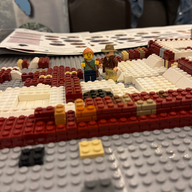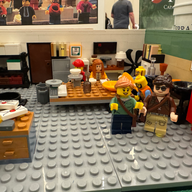Digging into Archaeological Preservation (and a Fun Fact for 2025!)
- TerraX Team

- Jan 10
- 5 min read
Happy New Year, Xplorers!
Boy, am I excited to introduce you to our special guest today. Y’all know my colleague Emma… Well, back in the fall, when she went to the Southeastern Archaeological Conference, Emma met one Nikki Mattson, and these two were fast friends!
Those of you who were at SEAC 2024 will remember that we brought a few of our LEGO set-ups to show at our table. Well, it turned out that Nikki was hoping we’d do just that. She’d been following along with our LEGO mitigation, and she even brought her own LEGO minifig (an anniversary present — thanks Mr. Nikki!), who got to meet all of our people! Here’s LEGO Nikki hanging out with our Lab Team — they definitely had a good time!
Emma and Nikki got to talking, and we realized she’d be an amazing person to introduce to you, the Xplorers! Nikki works for The Archaeological Conservancy — which is a whole side of the archaeology world we, at TerraX, hardly ever get to see.

You see, there’s actually a real-life team of real-life treasure protectors whose job is to save cultural sites from bulldozers, looters, and the forces of nature. Yup — it’s called archaeological preservation, and it’s what The Archaeological Conservancy is all about. They’re a non-profit that has been preserving history since 1980, and they’re here to show you — if you think archaeology is all about Indiana Jones-style treasure hunting, think again. There’s so much more to the story (Good news: no snakes involved… for you. Nikki has encountered all manner of snakes, ticks, and other creepy crawlies in the field!).
Today, we’ll explore the world of archaeological preservation, meet Nikki herself, and learn your new fun fact for 2025!
What Is Archaeological Preservation?

Archaeological preservation is all about saving cultural sites so we can learn from them for generations to come. These sites might be mounds, ruins, or even boggy burial grounds, but they’re all important because they’re all full of data. Xplorers from way back may remember that we in the CRM world regularly perform Section 106 surveys; that’s to say, we look at the locations of potential development projects to see if there are any archaeological sites that may be impacted by the proposed development. If we find any sites that may have more data for us to uncover, we report that back to the client, and then they get to decide whether they would prefer to sponsor further research in this area or move their proposed development somewhere else. If they choose to move on, the site will be left alone until somebody else comes along who wants to investigate further… or until The Archaeological Conservancy gets there to protect the site!

The Archaeological Conservancy is a national nonprofit that protects archaeological sites by buying the land, working with property owners, and even placing easements on areas to ensure no one starts building a mall on top of the ruins. Their goal is to keep these places in their natural state, safe forever. That way the site is protected from future development and looters, who may steal artifacts to keep or sell. It’s really a beautiful way to ensure cultural remains are either undisturbed or investigated with the proper care and attention they deserve.
A Day in the Life of a History Hero
Nikki Mattson didn’t grow up dreaming about saving Native American mounds or looking out for looters. In fact, her first career aspiration was to teach middle school social studies, but life had other plans, as it so often does.
While in college, Nikki took a geography class taught by a professor who introduced her to archaeology. “Archaeology chose me,” she says. “It was not in my plan at all.” From that first experience just dipping her toes into the archaeology world, Nikki was hooked. Though it was a long journey of hard work and true dedication to realizing her passion, today, she’s the Southeast Field Representative for The Archaeological Conservancy, helping to oversee sites in eight states from Louisiana to South Carolina.

But what does her job look like day to day? I’m glad you asked! That’s the best part — the truth is, it’s a mix of adventure and problem-solving, and Nikki is never bored. She does get to visit sites to check for looting, so she gets to travel around the Southeast. Sometimes she coordinates with landowners to ensure the areas stay protected, and other times she even gets to participate in digs. But her favorite part? Meeting people — whether it’s archaeologists, site stewards, or curious kids who want to learn about history, meeting new personalities and sharing her love of history and archaeology with the world is the best part of the job.
Amazing Sites and Stories
The Archaeological Conservancy protects close to 600 sites nationwide, each with its own fascinating tale. Here are a few highlights:
The Sloan Site (Arkansas): The oldest open-air cemetery in North America. Instead of burying their loved ones underground, long-ago people placed them on the surface. Archaeologists have installed cameras to keep this site safe from looters.
Windover (Florida): A site where people were buried in a peat bog, so well-preserved that brain tissue was still intact after thousands of years.
Jaketown (Mississippi): Predating the famous Poverty Point, this site holds secrets of an earlier mound-building culture.
Fun Fact for 2025: You Can Be an Archaeologist!
Here’s some good news: You don’t need a PhD to get involved in archaeology. The Conservancy welcomes volunteers of all ages! You can participate in official visits to preserved sites, tune into virtual tours and lectures, and even join a dig. Archaeology isn’t just for the experts — it really is for anyone with a curiosity about the past, and there are opportunities open to the community all over the region.
If you’re ready to be part of the adventure like I was after talking to Nikki, here’s how you can join in the great work of The Archaeological Conservancy:
Visit a Site: All Conservancy-protected sites are privately owned, but some, like Ingomar Mound in Union County, MS, are open to the public, and even for sites that are not typically publicly open, you can often arrange a visit by contacting the Conservancy. Take a trip to a mound or ruin near you!
Volunteer: Join a dig or become a site steward. You’ll help protect history while getting your hands dirty (in a good way).
Donate: Support the Conservancy’s mission to acquire and maintain sites for future generations.

Nikki specifically recommends visiting sites like Prospect Hill Plantation in Mississippi, where the public can participate in excavations. And who knows? You might discover something incredible! Whatever you find, you’ll be helping an essential non-profit to protect archaeological knowledge and gather priceless data that will continue to inform our understanding of the past.
Nikki sums it up beautifully: “I can read things all day long, but until I do it myself and it becomes personal, it doesn’t really solidify.” Archaeology connects us to history in a way that text can’t. If you’re ready to make that connection, a quick Google search for opportunities to volunteer with the Conservancy near you is all it takes!
Superheroes for History
Archaeological preservation is like being a superhero for history. Thanks to people like Nikki Mattson and The Archaeological Conservancy, pre-Contact and recent historic stories are safe for us to explore. So grab your trowel (or at least your sense of curiosity), look for opportunities to volunteer or get involved, and start digging into the past. You never know what you might discover!





















Comments